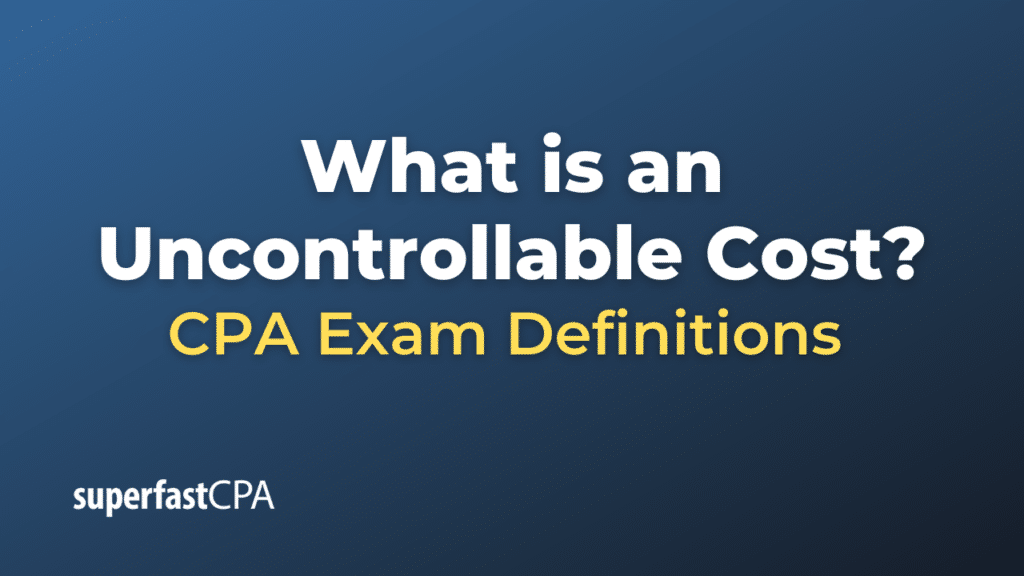Uncontrollable Cost
An uncontrollable cost is a cost that cannot be directly influenced or altered by a specific manager or department within an organization. These costs are often fixed in nature and are not susceptible to changes in operations, output, or managerial decision-making at the unit level. In other words, regardless of the actions or decisions of a specific manager, the cost will remain the same for the period under consideration.
Characteristics:
- Higher-Level Decisions: Uncontrollable costs are typically the result of decisions made at a higher organizational level, such as corporate headquarters, and they are allocated across various departments or divisions.
- Long-term Commitments: These costs often stem from long-term commitments, such as lease agreements, loan payments, or multi-year contracts.
- No Direct Influence: The key aspect of an uncontrollable cost is that the manager in question does not have the authority or capacity to change the cost, either because it is contractual, regulated, or determined by other parts of the organization.
- Not Useful for Performance Evaluation : Since these costs are outside the control of individual managers, they are generally not used for the purpose of evaluating managerial performance.
Examples:
- Corporate Overheads: A department manager cannot control corporate administrative expenses allocated to their department.
- Interest Payments : Interest payments on loans are typically uncontrollable costs for department managers.
- Taxes: Property taxes, sales taxes, and other forms of governmental levies are usually uncontrollable costs at the department level.
- Depreciation: This is often considered an uncontrollable cost for a department or unit manager, especially if the assets were purchased as part of a company-wide decision.
Considerations:
Even though some costs are uncontrollable at a lower managerial level, they may be controllable at a higher level within the organization. Therefore, classifying a cost as uncontrollable can depend on the level of management being considered.
Understanding the distinction between controllable and uncontrollable costs is crucial for effective budgeting, performance evaluation, and operational planning.
Example of an Uncontrollable Cost
Let’s look at a fictional example involving two departments within a larger corporation, XYZ Corp., to illustrate the concept of uncontrollable costs.
Scenario:
XYZ Corp. has various departments, including a Marketing Department and a Research & Development (R&D) Department. The corporate headquarters allocates a portion of the company’s overall interest expense from corporate loans to each department based on their respective expenditures.
- Total Corporate Interest Expense for the Year: $100,000
- Allocated to Marketing Department: $25,000
- Allocated to R&D Department: $15,000
Situation 1: Marketing Department Manager’s Perspective
Jane, the manager of the Marketing Department, has control over several costs like advertising expenditures, employee salaries within her department, and office supplies. However, the $25,000 interest expense allocated to her department is an uncontrollable cost from her perspective. She did not take out the corporate loan and has no authority to renegotiate its terms or pay it off.
Jane’s performance evaluation will likely focus on how well she manages the controllable costs (like advertising expenditures), rather than the uncontrollable interest expense allocation.
Situation 2: Research & Development Department Manager’s Perspective
John, the manager of the R&D Department, faces a similar situation. The $15,000 interest expense allocated to his department is also an uncontrollable cost for him. Like Jane, John has no control over this corporate decision. He can control research costs, employee salaries in his department, and other operational expenses, but not the allocated interest expense.
What This Means for XYZ Corp:
In both these cases, the interest expense is a fixed, uncontrollable cost for Jane and John. This is a critical distinction because:
- Budgeting : When planning the budget for the next year, these department managers would treat this allocated interest cost as a given, focusing instead on areas where they can exert control.
- Performance Metrics: These uncontrollable costs are usually excluded when evaluating the performance of these department managers, ensuring that they are assessed only on areas they can influence.
- Management Decisions: Knowing which costs are controllable and which are not helps higher-level management make more informed decisions about resource allocation, efficiency improvements, and managerial accountability.
Understanding the difference between controllable and uncontrollable costs is important for both budgeting and performance evaluation, allowing each level of management to focus on what they can actually influence.













